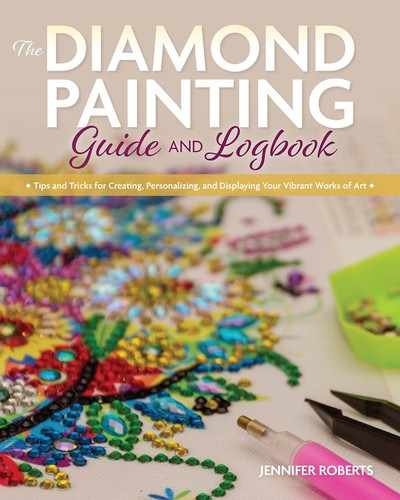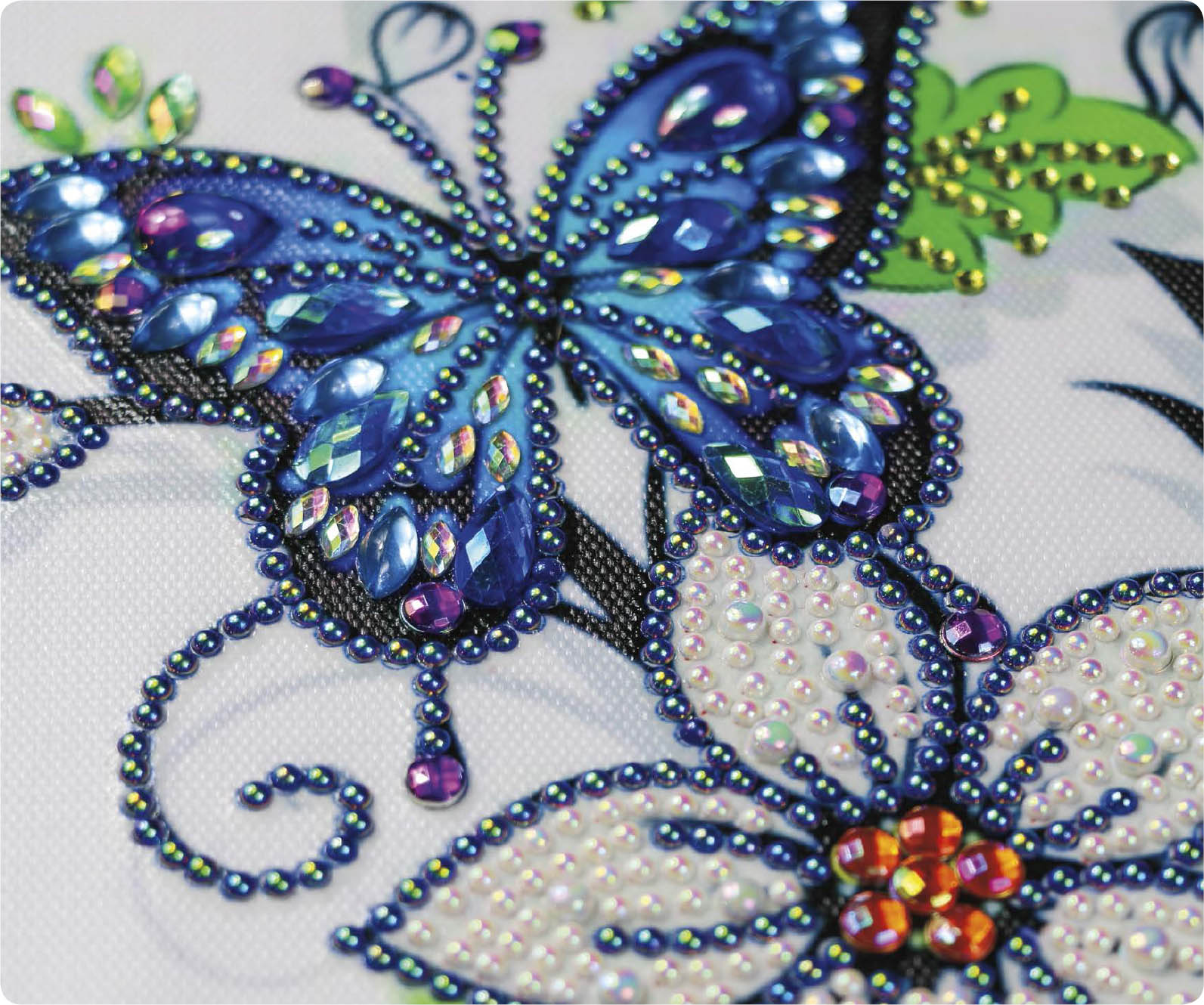INTRODUCTION
When someone has an addiction, they dive in, changing their life to accommodate it. While addictions can be harmful, they can also be very positive. And this is where my story begins.
I am a trauma therapist who has worked with human-trafficking survivors and refugees from around the world. My heart goes out to those who have lost their voice, journeyed to reclaim it, found freedom, and endeavored to be all they were born to be. My work takes immense amounts of emotional energy. And although I love every minute of supporting my clients, I also need to renew my own emotional tank. This is true for everyone, which is why we seek out ways to relax, unwind, and enjoy life. We desperately need positive distractions to recoup from our demanding daily existence.
At times I’ve acted like I’m a superhero and ignored self-care. But when one neglects one’s self, one becomes susceptible to addiction—mine became diamond painting.
There was a period in my life when I did not follow my own self-care advice and found myself ill for the umpteenth time. Lying in bed for the third day in a row and miserable, I started scrolling Facebook. Between my best friend’s post about something cute her child said, and the neighborhood-watch page about another lost dog, was an advertisement. In my cold-medicated state, I clicked on the video. It entranced me with amazing colors and sparkles, the words crafting, do it yourself, and 50 percent off. I was instantly hooked.
The ad was for a new craft called diamond painting. I am an avid crocheter, scrapbooker, and photographer and could not resist the allure of a new art discipline. I scrolled through the company’s catalog until an image caught my eye. I couldn’t find my wallet fast enough. Little did I—or my husband—know that one advertisement was going to forever change our lives. I entered my debit card number, clicked the purchase button, and waited for the confirmation page to load. Smiling, I laid back in bed and drifted off into a blissful sleep.
A few weeks later, I received a package. I remember it like it was yesterday. The Winter Olympics were on TV, it was pizza night, and I was about to try and figure out how to do this craft with directions that were only in Chinese. In the box was a canvas on which were symbols, numbers, and glue. There was a cover atop the glue for protection. There was also a stack of little plastic circles.
With instructions in a foreign language, no YouTube channels to refer to, and no hype from the crafting world, I was lost. Seriously, what had I gotten myself into?
My husband still laughs today when he remembers watching me awkwardly holding the pen-like, hollow plastic, pink object that had a metal tip on the end. I assumed it must be the tool for putting the plastic circles on the canvas, but how were they going to stick to the pen, I wondered? Ten minutes later, fully frustrated, I looked down to the floor and saw a little pink square of something squishy and soft. To this day I don’t know why, but I poked the metal tip into the doughy substance and the pink goo went into the pen.
Another 10 minutes of experimenting and I figured out that the pen was the applicator and the pink item was wax that allowed me to pick up the plastic circles and then place them on the canvas, based on the color-coding key (insert deep breath here). Although I’d missed half of the Olympic luge competition, I had earned my own gold medal—discovering diamond painting and the endless joy it was about to bring to my life.
Working on my first diamond painting, I was amazed how my stress levels began to drop. Joy began to filter back into my life. Who would have guessed that thousands of little plastic pieces and glue could change the trajectory of my life? Once the painting was complete, I asked my husband his thoughts on me purchasing one painting a month. Our budget could handle $10–$20 a month if it brought me peace, he said.

My first diamond painting, “Teal Tree” from Paint with Diamonds.
Now, as I look back, one painting a month is laughable. I went head first down the diamond painting rabbit hole and there is no coming back. I know the diamond painting vocabulary as if it were my second language. I’ve accumulated enough diamond paintings to request a special insurance policy (wink). I started a YouTube channel and Instagram page, and now you are holding my first book.
The moral of my journey—and this book—is that balance is essential. All work and no play, or all play and no work, is not the best recipe for success. I urge you to find something you love and share it with the world. You are important, valued, and worth the time and energy it takes to rejuvenate your soul.
WHY DIAMOND PAINT?
When I show my diamond paintings to friends, family, and strangers, the first thing they ask—after oohing and aahing at my creations—is, “Why do you diamond paint?” Initially, I didn’t know how to answer. I just knew it helped me unwind like nothing else. I’m contemplative by nature, so I pondered the question, which led me to the reason I diamond paint.
PSYCHOEDUCATION OF THE BRAIN
Psychoeducation is a fancy word to describe why we respond to something the way we do. Life is tough, stress is no joke, and when time allows for relaxation, it is nearly impossible to truly rest. Why is this? The best explanation is Dr. Daniel Siegel’s “Hand Model of the Brain,” as I have found it offers the simplest yet most accurate reasoning behind our actions when stressed.
Imagine your brain as your fist with your thumb hiding under your fingers.
The wrist. The wrist represents our “survival brain” and is the part of the brain that forms first in the womb. It symbolizes our autonomic nervous system, which controls unconscious bodily functions such as breathing, blinking, and heart rate. The “survival brain” keeps us alive and therefore is equipped with an alarm system. When we are threatened—physically, emotionally, or mentally—our “survival brain” alerts us that we are in danger. The body then begins producing the hormones cortisol and adrenaline, which increase heart rate and quicken breathing, putting us into fight-or-flight mode. In this state, we are at our most vigilant, but also our most stressed. As the situation calms, alarms quiet and our “survival brain” releases the neurotransmitter acetylcholine, which allows us to begin breathing more deeply and return to a relaxed mood.
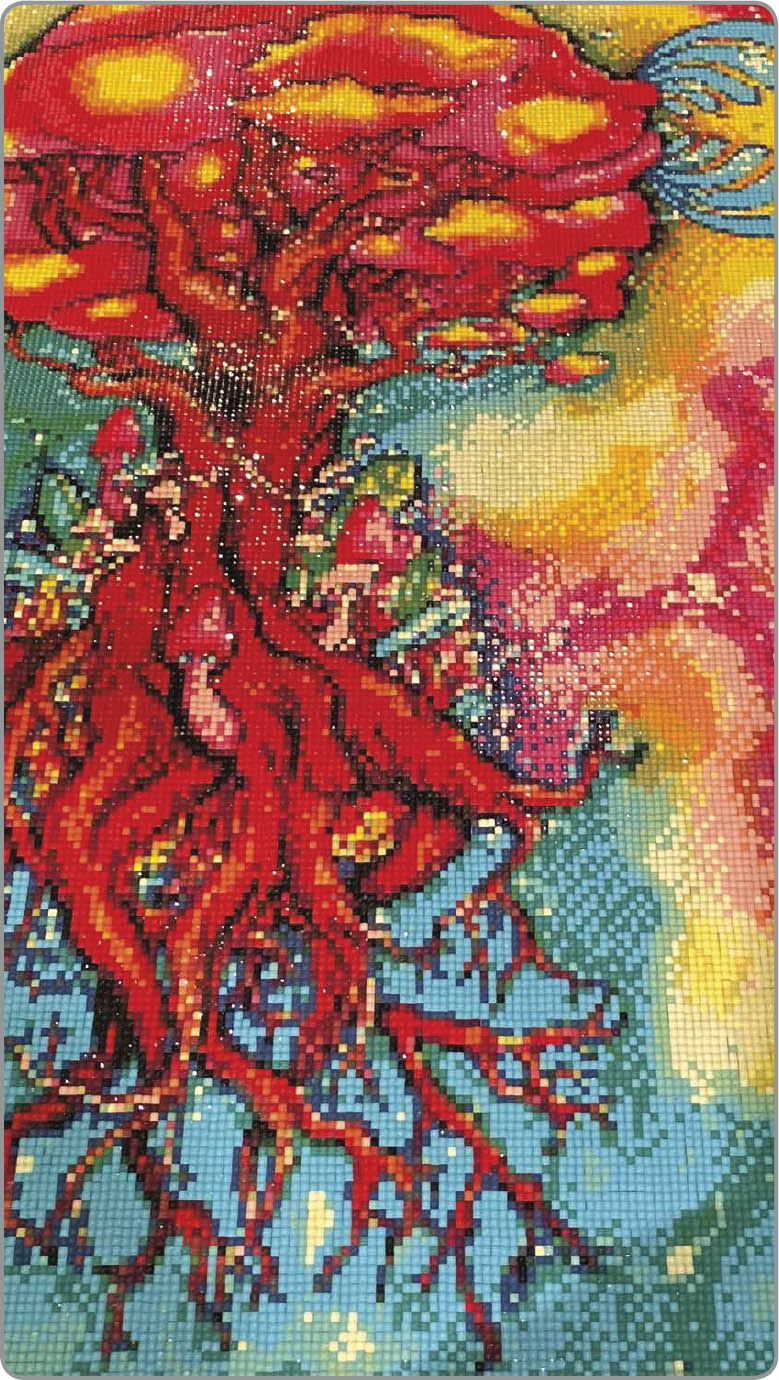
At least this is what is supposed to happen. In today’s complicated, stressful world, our “survival brain” is overtaxed; we find ourselves in an unhealthy cycle in which our fire alarm is going off repeatedly, putting undue stress on our bodies. As more cortisol and adrenaline are pumped into our system, it not only becomes harder to return to a place of calm, we also go from zero to 10 with the slightest trigger. This proves exhausting on our brains and bodies and leads to less restful sleep, irritability, and high levels of anxiety.

The thumb. The thumb represents the “emotional brain.” Our emotions are a byproduct of the “survival brain” or the “thinking brain,” which is discussed in the next paragraph. The more often the fire alarm goes off, the more it feeds our “emotional brain,” which expresses itself through fear, sadness, loneliness, anger, and other states of mind. The “emotional brain” and “survival brain” become best friends playing off one another to create the perfect storm for trauma triggers and stress.
The four fingers. The four fingers folded over the thumb represent the cerebrum, also known as our “thinking brain.” This is the outer, grooved portion of our brain and it controls logic, problem-solving, speech, learning, and, of course, thinking. When we add 2 + 2 or decide what to make for dinner, the “thinking brain” is working.
The “thinking brain” and the “survival brain” react to each other like oil and water—when the “survival brain” is activated the “thinking brain” disappears, and vice versa. For example, if a car is speeding toward us, we don’t want our “thinking brain” in the way trying to calculate how much time we have before impact or to determine what color the car is. We need our “survival brain” to tell us to jump out of the way and fast.

Ideally, when the threat has subsided, our “thinking brain” retakes the reins. These days, however, people are in a perpetual state of stress and so the “survival brain” is consistently running the show, never allowing our “thinking brain” to take over. We need to engage our “thinking brain” to calm our emotions and bring us back to reality and peace.
So, what does this have to do with diamond painting?
In therapy, one of the concepts first addressed is how to bring the “thinking brain” back. I have found that the easiest way to do this is by focusing on something we normally do not control, such as breathing. Breathing is regulated in the “survival brain,” but we can use our “thinking brain” to wrest control of it and therefore calm our whole system. Take a moment right now and breathe in slowly to the count of three or four. Hold it for a second or two, and then breathe out to the count of four. Okay, do it again. Do you ever wonder why you sigh deeply from time to time? It’s not just to catch your breath, it is your mind saying it needs a moment.
As you begin to incorporate mindful breathing into your life during stressful times, your “thinking brain” takes charge, and, in return, you feel more in control.
Let’s take what was just discussed and apply it to diamond painting. You sit down in front of a pile of beautiful colors and organize them into a coding system. You are problem-solving—taking chaos (so to speak) and creating order. As you do this, your “thinking brain” prompts you to breathe slowly and deeply. Taking diamonds from a tray and placing them on a mapped-out canvas requires concentration on one thing only (similar to focusing on four-count breathing).

All five senses are employed during diamond painting, helping you to become grounded. (I could write a whole book on grounding techniques.) Taste, touch, sound, sight, and smell are used to supplant your “survival brain” with your “thinking brain.” Notice how your drink or snack tastes, how the stick of the adhesive feels, the sound of the clicking of the diamonds, or the music/YouTube/streaming content you are bingeing. See how colorful the painting is becoming and consider the smell of diamonds or wax. All of these senses communicate to your brain that you are aware of your surroundings, in control, and safe. You no longer have to be hypervigilant. Diamond painting allows your mind to return to equilibrium.

“The Princess and the Frog” design by Mandie Manzano from Diamond Art Club.
This is one reason diamond painting becomes addicting—you begin to crave the sense of peace it creates. Other crafts can offer a sense of calm, but diamond painting allows the mind to go on autopilot due to the mapped-out pattern and the way the kits are designed. Your brain doesn’t have to count stitches, pick colors, or worry about cracks, it can just craft.
I encourage you to find a flat surface, lay out a diamond painting, pick up a pen, and begin a new healing journey. You will not be disappointed!

“The Sweet Life” design by Chuck Pinson from Diamond Art Club.
HOW TO DIAMOND PAINT: THE BASICS
Many crafters are familiar with cross-stitch and its ability to combine small dots of color and create masterpieces. Although completing a cross-stitch pattern may not take as long as painting the Sistine Chapel, it is not unusual for a detailed project to take years. This is one reason why, in 2015, diamond painting became a popular crafting trend. “Diamond Painting was designed as an easier, faster, and more therapeutic alternative to Cross Stitch,” explained the popular diamond painting company, Paint with Diamonds. And while diamond painting has cross-stitch at is core, it utilizes multiple craft mediums, including paint by numbers and mosaic tiling.
While each company decides what tools it offers, the following are mandatory.
- Canvas with pre-laid adhesive
- Key for color (connecting symbols to color palate)
- Application tool (to place diamonds on to canvas area)
- Set of diamonds labeled with color key
- Tray to hold diamonds to be placed
- Sticking agent, usually referred to as wax, to use with the application tool
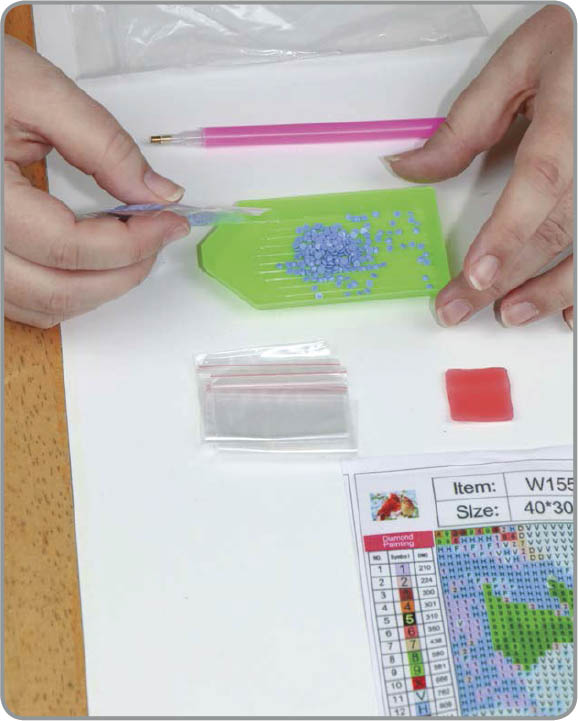
Other tools in the kit may include:
- Plastic bags for storage
- Tweezers for different way of placement or removal as needed
- Wax container
- Higher-quality tray
- Inventory page for quick review of color key
- Stickers or gift from company as a thank-you
- Different placers to use with the applicator tool
- Foam squishy for applicator to help ease strain on hand when holding
- Canvas sheet protectors
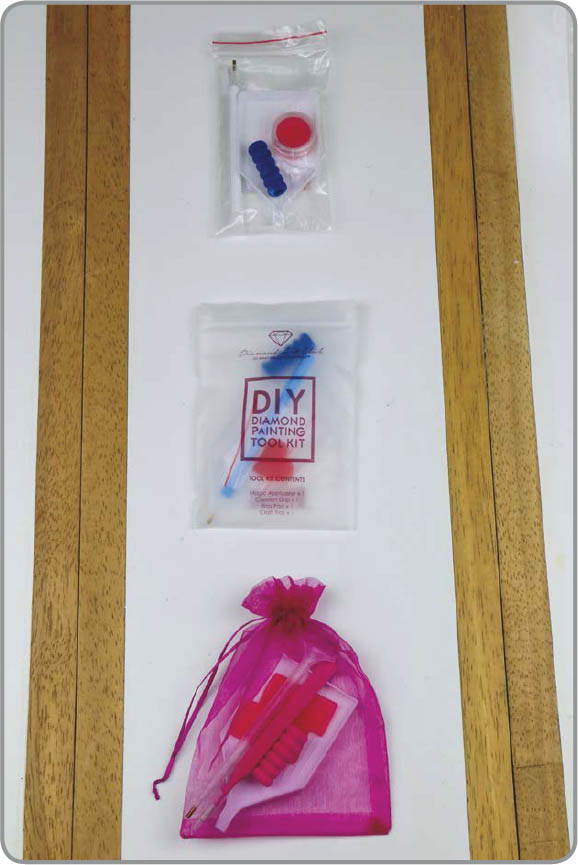
The list continues to grow and change as companies explore new ways to improve their customers’ experience.
HOW TO DIAMOND PAINT
STEP 1  SELECTING A DIAMOND PAINTING
SELECTING A DIAMOND PAINTING
While people often choose paintings based on colors, designs, subject matters, size, and types of diamonds included (specialty diamonds), the most important criteria is to select a painting that will bring you joy. Once you’ve decided on a painting, be sure to research the company selling it to ensure it is really the one you want—the photos used are oftentimes misleading. I have learned to read the fine print when searching for round drills vs. square, full vs. partial, rhinestones vs. regular, etc. As you continue reading, these terms will hold more meaning in your diamond painting journey.
In terms of size, larger is usually better (see the section on canvas sizing). Since diamond painting creates a picture from small dots, the larger the canvas, the more detailed—and less pixelated—your painting will be. Balance your size selection; you don’t have to choose a large painting each time. Experiment and find your sweet size. My favorite is the 40 x 50 cm, as my arms can reach every part of the canvas, the details are easy to see, and it’s an inexpensive size to frame and still be a statement piece.
Check out Facebook groups, YouTube channels, and reviews when seeking reputable companies. Sometimes cheaper is not always better. See the resource section for some of my favorite companies and stores if you need a place to start.
pro tip
If you are ordering from overseas, be prepared to wait three to eight weeks for it to arrive. Monitor the tracking number, follow the policies of the websites you are ordering from, and if you have questions, ask. Remember, if you are ordering from overseas the customer service representative may not speak English. Use short, simple phrases, only ask one question at a time, and know you may not get an answer for up to 24 hours or over a weekend due to the time difference.
STEP 2  ORDER, RECEIVE, AND INVENTORY
ORDER, RECEIVE, AND INVENTORY
Once a painting is ordered, keep your confirmation and tracking numbers. When the diamond painting arrives, take inventory. Check the canvas for damage, the diamonds for any missing colors, and evaluate if the painting is indeed what you ordered. Hopefully, you have a great experience, but in the rare case that your painting is not satisfactory, contact the company’s customer service for assistance. If ordering from certain Chinese companies, you will be asked to verify receipt. WARNING: Do not verify unless you have checked out your canvas, as verification shuts the door on possible customer service assistance if anything needs addressed.
Inventory Inventory means comparing the diamonds received with the key and/or inventory sheet. Each package of diamonds should correspond to the key. Some companies will weigh their diamonds and only give you one package per color, but it will contain different amounts of drills. Other companies will give you standard-sized packets containing set numbers of diamonds, therefore you will have several packets of each color. For example, each packet may include 200 diamonds and you need 1,250; your inventory should be 7 packets = approximately 1,400 drills.

STEP 3  KITTING UP
KITTING UP
This is a term universally used by diamond painters when speaking about assembling their next project. Kitting up involves organizing your diamonds how you desire, labeling storage, and clearing a crafting space for diamond painting. For the avid painter, there could be multiple paintings kitted up at any given time. (See storage section for further details.)

When kitting up, it is important to label how you as the crafter think. Options available are to label using the DMC number (if provided), the symbol/schematic, or the number order of the color. In the picture provided, you see the package of the diamonds and the key with the #12 highlighted. In this example, you could use #12, H, or the DMC code 809 on your storage. I prefer to make a photocopy of my canvas key and inventory sheet, which I then cut up and tape onto my storage box.

pro tip
Invest in a sticker-making machine (Xyron is a good brand) and make your own stickers by running a cut-to-size strip of the key through it, therefore bypassing the need to use tape.
diamond painting lingo
Kits/Stash If you watch YouTube or follow Instagram, you may see a phrase similar to “20 kits in my stash.” In crafting terms, this means 20 diamond paintings purchased (and probably hidden from a significant other—seriously, the addiction is real).
Kitted Up Refers to a craft already organized and ready to be worked on.
STEP 4  DIAMOND PAINTING
DIAMOND PAINTING
- AThe painting is laid out, the diamonds are organized, the popcorn is popped, and your favorite YouTube creator is playing on your tablet. Now it is time to peel back a corner of the canvas cover (do not remove cover completely) and reveal the symbols and paint.
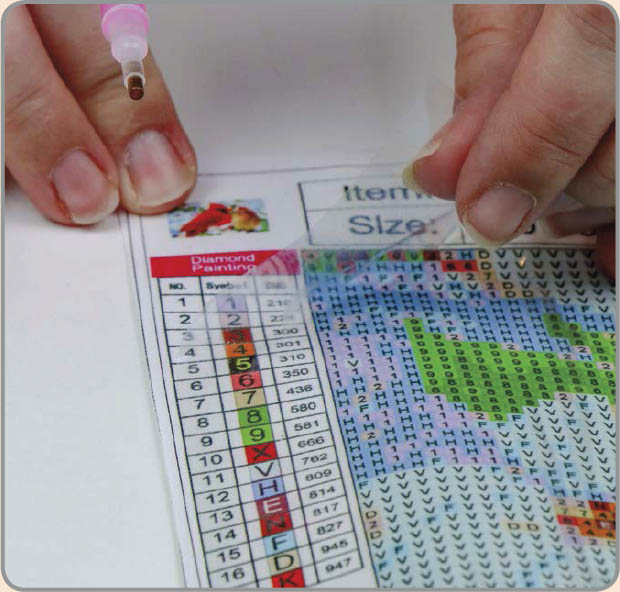
- BSelect a symbol, compare it to your color key, find the correct diamond color, and pour an appropriate amount into a tray. Shake the tray gently to help the diamonds lay flat. The sparkle side should be facing up.

- CPick up your diamond painting pen and push the tip into the wax. Next, gently place the pen tip on a diamond and allow the wax to adhere.

- DLift the diamond from the tray and navigate it over to the correct corresponding symbol; press pen and diamond to the symbol. The canvas glue will be stronger than the wax and will take the diamond from the pen.
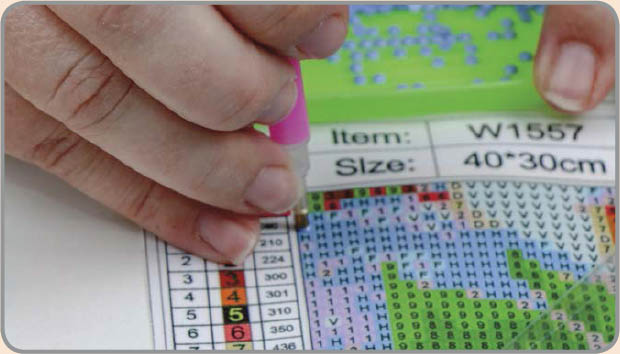

Cross Country Choosing a color drill and placing the color across the whole canvas until all the symbols of that hue are completed.
Parking Staying within a set section (e.g., 4" x 4") and completing all colors within this space before moving to next section.
Checkerboarding Checkerboarding is mostly used with square diamonds. Take an area with the same symbol and create a checkerboard design by placing diamonds in every other category. This helps square diamonds line up more evenly: when the missing spaces are filled in, the square diamonds will snap into place.
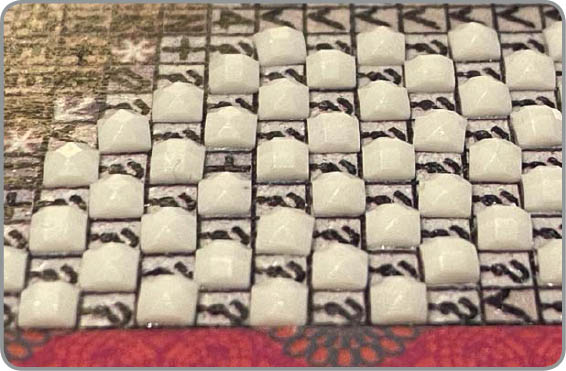
CHECKERBOARDING
Strategies for diamond painting are as individual as the artist working. Some diamond paint one color at a time across the whole canvas, others choose section by section. Some paint one diamond at a time, others use multiplacers. Pens, trays, wax, glue, and other accessories also vary from crafter to crafter. This book will explore a few unique strategies while encouraging you to find what is right for you.
pro tip
When you have completed your diamond painting for the day, re-cover your canvas to protect unfinished and exposed areas. This will keep dust, fuzz, paper, or accidental spills from marring your painting.
STEP 5  FINISHING A DIAMOND PAINTING
FINISHING A DIAMOND PAINTING
There is a sense of satisfaction when the last diamond is placed. (If you are like me, you may already have your next kit/painting selected and ready to go.) However, what to do with the one just completed is the urgent question of the day.
- AFirst, take a roller and roll over the painting. This presses the diamonds into the canvas glue and continues the adhering process.

- BPass a scrub brush gently over the diamonds to help remove any dirt and waxy residue (or grease from the popcorn you ate). Some people use a toothbrush, but I find them too soft. I use a small-handled bristle brush, like the kind you might use to scrub your sink. Be gentle when “scrubbing” your canvas clean.
- CDecide if you are going to seal or leave your painting natural. I seal paintings I store in my artist portfolio or they will be open to the elements. If I am framing, I will bypass the sealant as the glass provides the needed protection. Sealant protects diamonds from flaking off from a variety of reasons, and I would rather be better safe than sorry if it’s a painting with meaning.


FINAL THOUGHTS
My hope is for your journey to be as inspirational and soul searching as mine has been. Since discovering diamond painting I have found myself more patient, self-assured, and open to new possibilities. My depression and anxiety have substantially lowered, and my self-esteem continues to increase with each masterpiece. If a painting is causing stress, I have become decisive and throw the painting away without guilt. I have found the ability to control my decisions, be proud of my accomplishments, and find peace in seeing the chaos of color become complete, organized, and whole. Diamond painting (or any craft of your choice) should bring you on a journey of rest and renewal. May you find the restoration and renewal you deserve as you embark on your crafting journey.
